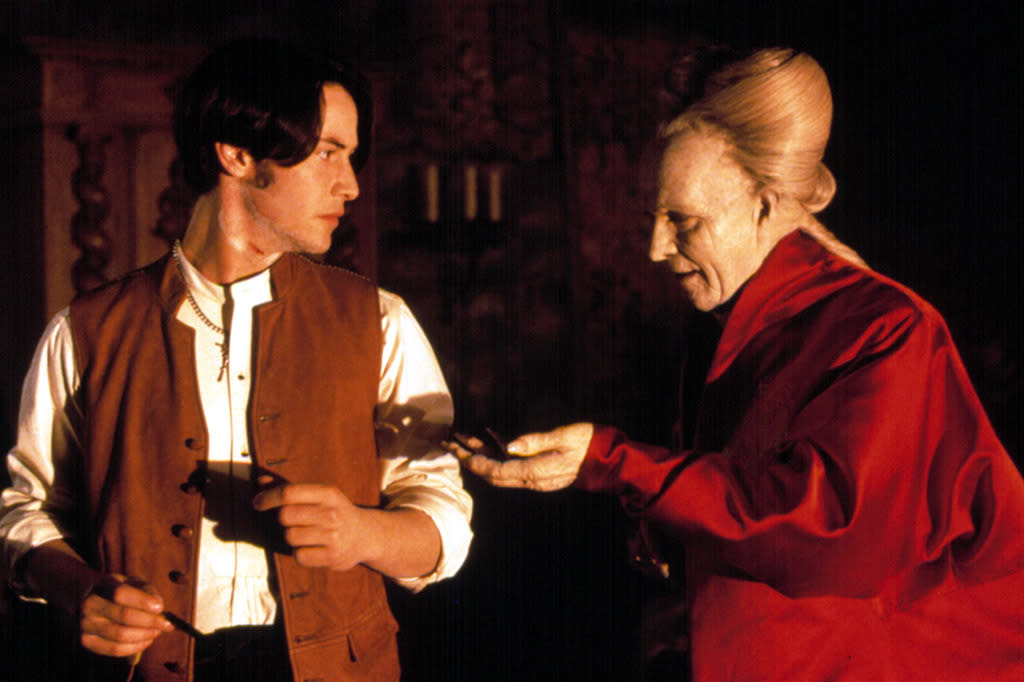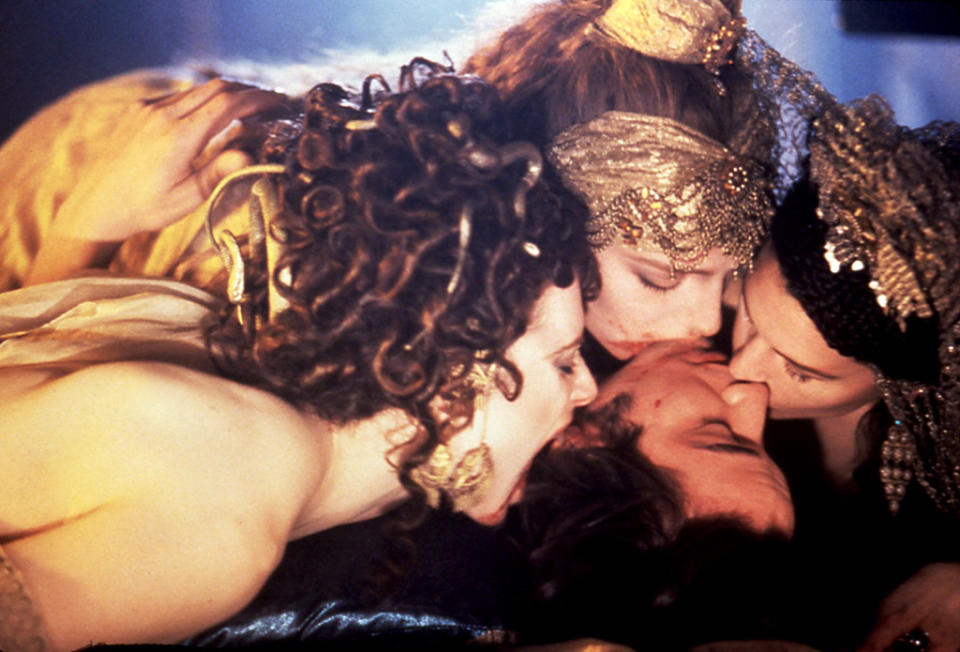Francis Ford Coppola Looks Back on 'Dracula' and Reflects on Hollywood’s Superhero Obsession

Keanu Reeves and Gary Oldman in ‘Bram Stoker’s Dracula’ (Everett)
After spending the 1970s as one of American cinema’s most successful filmmakers — and then trudging through a 1980s filled with misfires and financial struggles — Francis Ford Coppola began the ’90s by turning back the clock. In 1990, he wrote and directed The Godfather: Part III, which earned seven Academy Award nominations and made the then-51-year-old filmmaker a hot commodity once again. As a follow-up, he decided to go even deeper into the past, setting his sights on one of cinema’s original antagonists: Dracula.
The movie was inspired in part by a clear-the-air meeting with Winona Ryder, whose last-minute exit from The Godfather: Part III delayed the film, and who suggested Coppola read James V. Hart’s screenplay for Bram Stoker’s Dracula. As the title suggests, the script hewed closely to Stoker’s original 1897 novel, a fact that excited Coppola, who was eventually hired by Columbia Pictures to direct the $40 million period adaptation. In turn, the director assembled an all-star cast, including Gary Oldman as the immortal bloodsucker; Anthony Hopkins as Van Helsing; Keanu Reeves as London lawyer Jonathan Harker; and Ryder as Mina Murray, the reincarnation of Dracula’s late wife, Elisabeta.
Despite speculation about problematic test screenings and rising costs — the film was nicknamed “Bonfire of the Vampires” by the movie press, a reference to the notoriously bloated 1990 dud The Bonfire of the Vanities — Dracula went on to be one of the biggest films of 1992 and one of the most successful of Coppola’s career, scoring $215 million worldwide and winning Oscars for costumes, makeup, and sound effects. On Tuesday, Bram Stoker’s Dracula was released on Blu-ray, and Coppola spoke with Yahoo Movies about the film’s throwback special effects, its surprisingly racy sex scenes, and Twilight.
This is a very different Dracula than the one we’ve seen on the big screen up to this point — it depicts the vampire as a sad, lovesick warrior miserable in immortality.
I didn’t write the script; I was just hired as a director. But I liked the fact that the script was similar to the book. I read the entire book, and I felt if I could do it the way the book was, that might be fun. And I realized the book had been written right around when movies were first invented — when films were being made by magicians and had lots of magic in them. And I thought I would use those techniques, and do it on the stage, and make it an homage to early films. That began to suggest an unusual style for it.
Were there any magicians or old filmmakers that were particularly influential?
A lot of the film was inspired by the great Jean Cocteau’s [1946 classic] Beauty and the Beast, and by the original magician who became a filmmaker, Georges Méliès — the subject of Hugo, which Marty [Scorsese] made. In the early days of movies, many moviemakers were really magicians using the new medium to try to perfect the illusions.
It’s a whole different ball game with the industry’s visual effects.
They can do anything. I find lots of times in [modern] movies, when some extraordinary thing happens, you don’t think it’s a big deal, because you know it’s fake — as opposed to letting the audience really be involved and think, “What’s happened? That’s extraordinary!” Also, I had my son Roman work on the movie. He was at a young age, was very interested in magic, and did a lot of research by reading books about illusions and how the turn-of-the-century magicians did them. That was his first big movie project, the live-action effects on Dracula.
One of my favorite scenes involves Lucy (played by Sadie Frost) vomiting blood all over Anthony Hopkins. What kind of moviemaking tricks did you use to create that?
A lot of scenes I shot backwards, and then we played it forward. And when you have a blood [effect], there’s a rig that’s coming out of a tube, and at the right moment, it looks like it’s spewing it out. The film had lots of in-camera effects, and it didn’t have any optical effects, and it certainly had no digital effects. So [there were] a lot of reverse-action and false-gravity scenes and illusions that came from the early magicians. And lots of live-action effects, meaning we really rigged something on the stage — like when the coachman extends his arm and lifts [Reeves]. That was done in real time.
Dracula is a very erotic movie, with lots of nudity and sex. Was it difficult to get the studio to sign off on all of this decidedly adult material?
In those days, it was after Apocalypse Now, [and] studios were frightened about directors going off to some faraway location and running out of control. So when I told them that I wanted to make it all right in their studio — right there at their [Columbia’s] stages — they were so relieved, they didn’t really pay much attention to the style. And generally, studios like it if [a movie] has some sort of sexuality and appeal, because they know it might make it commercial. Studios are much more concerned about cost.

Monica Bellucci and Keanu Reeves in ‘Dracula’ (Everett)
Now, more than ever.
That’s why I ended my career: I decided I didn’t want to make what you could call “factory movies” anymore. I would rather just experiment with the form, and see what I could do, and [make things] that came out of my own. And little by little, the commercial film industry went into the superhero business, and everything was on such a scale. The budgets were so big, because they wanted to make the big series of films where they could make two or three parts. I felt I was no longer interested enough to put in the extraordinary effort a film takes [nowadays].
It’s either gigantic films or really, really small ones.
The big ones have too much money, and the little ones don’t have enough.
Years after your Dracula was a hit, the modern vampire craze happened. What did you think of Twilight and its ilk?
Even though the Vampire myth had what you might call a renaissance with television and Twilight — which was kind of Romeo and Juliet as vampires — there were never two years that went without a new Dracula or vampire story. [Vampires] have always had a big hold on the movie audience right from the very beginning, and certainly the greatest Dracula of all was 1929’s Nosferatu, which was made as a silent film in Germany. And there were many Draculas made in my childhood: I loved Bela Lugosi as Dracula, and I remember John Carradine was a pretty good Dracula.
Since you’re not all that interested in the superhero industry, what are you working on nowadays?
I’m working on some very interesting stuff. But the trouble with writing and working on interesting stuff — and certainly ambitious stuff — is if you talk about it, you lose the energy to go write it. I feel it’s better not let the steam out by telling people about what I’m doing. It makes it easier to go back to the table to work if you haven’t spoken about it.
You’ve been on the cutting edge of technology, whether it was your 3D film with Michael Jackson, Captain EO, or your 2011 horror film, Twixt, which became 3D for several scenes. What do you think of virtual reality?
I am interested in some very new things that have only been possible for the last few years. It’s not exactly virtual reality — there are other exciting possibilities with cinema related to both virtual reality and the application of what essentially is the Oculus technology. [Or] just generally making cinema that’s networked with other people. There’s a whole list of possibilities that cinema could go in, in different directions, experimentally. The sky’s the limit. A lot of things haven’t been possible before that would [now] be fun to work in. And what I’m doing does make use of those possibilities.
The trouble is, like cinema originally, it takes a bit of experimentation. Early pioneers, when they made films at the turn of the century, they didn’t really know what they were doing but knew they had a wonderful facility, and so they experimented. They could get an idea of what worked and what didn’t. Often in the movie industry, no one wants you to experiment, so they can’t take the risk that something might not work. I’m in this very wonderful position where I can experiment. So every [few] months, I do an experimental workshop in which I try out ideas for my projects to see what works and what doesn’t.
So looking back on Dracula all these years later, what do you think of it?
I think it’s a very sumptuous, elegant, imaginative, strange project. I get a kick out of it because there were so many things we did that were chancy. We didn’t do the conservative thing, by any means. I like it when I get a chance to do that. Some things work better than others, and some people like some of the actors in it better than others. [But] you make a lot of films, and they’re like your children — and, in fact, the ones that people like the least that are the ones that are your favorite.
Watch the trailer for ‘Bram Stoker’s Dracula’ below:

 Yahoo Movies
Yahoo Movies 
